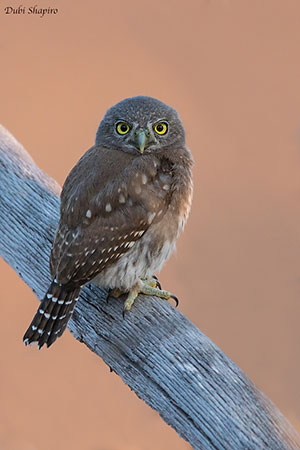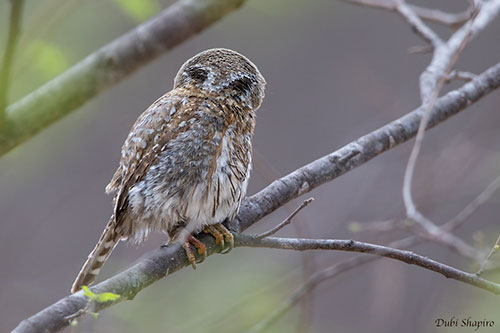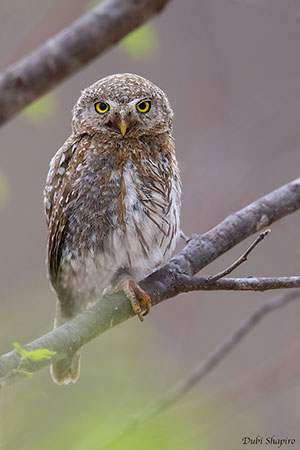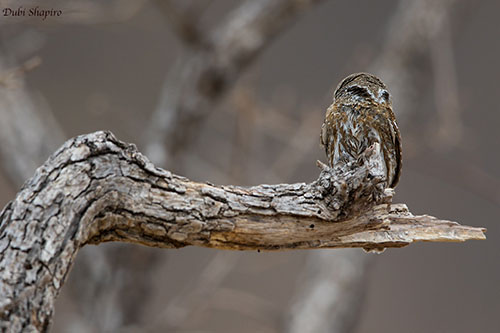
Fr: Chevêchette de Hoskins
Ang: Baja Pygmy-owl - Cape Pygmy-Owl
All: Hoskinszwergkauz
Esp: Mochuelo de Hoskins
Ita: Civettina del Capo
Nd: Bajadwerguil
Sd: californiasparvuggla
Photographer:
Dubi Shapiro
Dubi Shapiro Photo Galleries
Text by Nicole Bouglouan
Sources:
HANDBOOK OF THE BIRDS OF THE WORLD Vol 5 by Josep del Hoyo-Andrew Elliott-Jordi Sargatal - Lynx Edicions - ISBN: 8487334253
OWLS OF THE WORLD – By Claus König, Friedhelm Weick and Jan-Hendrik Becking - IBSN 978-0-7136-6548-2
Owling.com - The largest US website totally dedicated to owls
What Bird-The ultimate Bird Guide (Mitchell Waite)
Wikipedia, la enciclopedia libre
Baja (or Cape) Pygmy-Owl
Glaucidium hoskinsii
Strigiformes Order – Strigidae family
INTRODUCTION:
The Baja Pygmy-Owl or Cape Pygmy-Owl is restricted to the Mexican State of Baja California Sur and it is endemic to this region.
It frequents pine and pine-oak forests between 1,500 and 2,100 metres of elevation, but it reaches lower areas during winter. It typically feeds on insects, small mammals and birds, and reptiles. It nests in natural holes in trees.
The Baja Pygmy-Owl has restricted range in which it is described as rare or locally common. It is threatened by degradation of the habitat, but currently, the species is not globally threatened.
DESCRIPTION OF THE BIRD:
Biometrics:
Length: 15-17 cm
Weight: 50-65 g
The Baja Pygmy-Owl is a small Strigidae.
The upperparts are sandy grey-brown with reddish wash. Mantle and back show irregular pale spots, mostly pale buff on scapulars. On the upperwing, the flight-feathers have pale and dark barring. The relatively long tail (for a Strigidae) is crossed by 5-6 pale bars.
The underparts are off-white with conspicuous white spot on throat and central foreneck. This white area is surrounded by greyish-brown spots and streaks. The sides of the upper breast and part of the flanks are mottled greyish-brown. Rest of underparts shows dense dusky streaking.

On the head, crown and nape are grey-brown to rufous-brown with buffy spots. The facial disk is poorly developed, but there are narrow white eyebrows.
On the nape, we can see two conspicuous blackish spots edged with whitish above and pale buff below. They are very similar to “eyes” and are very useful for luring both intruders and predators. They are named “false eyes”.
The bill is greenish-yellow with pale greenish-grey cere. The eyes are yellow. The feathered tarsi and the bristled-toes are yellowish-grey. The claws are horn-coloured with darker tips.

The female is similar but she has darker reddish wash on the upperparts. She is heavier than the male.
The juvenile is undescribed.
RANGE:
The Baja Pygmy-Owl is endemic to the mountains of S Baja California in Sierra Victoria and Sierra de la Giganta, down to Cabo San Lucas.
HABITAT:
The Baja Pygmy-Owl frequents pine and pine-oak forests between 1,500 and 2,100 metres of elevation.
During winter, it usually moves to lower altitudes and occurs mainly in deciduous forests around 500 metres above sea-level.
CALLS AND SONGS: SOUNDS BY XENO-CANTO
The song of the Baja Pygmy-Owl is a series of short, single notes equally-spaced of about 1 second, relatively high-pitched with descending modulation towards the end “kwiu kwiu kwiu…”. This series is usually preceded by a quavering “huhuhu” sometimes leading to hooting.
BEHAVIOUR IN THE WILD:
The Baja Pygmy-Owl feeds on insects and various arthropods, but it also takes small mammals and birds, and also reptiles.
It probably hunts like other pygmy-owls, from a perch from which it searches for prey and once it is detected, it swoops down onto the ground to catch it. The prey is caught with the talons.
The owls of genus Glaucidium often catch large prey compared to the size of the owl itself. They generally pluck the prey before swallowing the food piecemeal.

The Baja Pygmy-Owl, like other species of genus Glaucidium, usually nests in tree cavities often excavated and abandoned by woodpeckers.
This species is resident, but some altitudinal movements are reported during winter.
The fly is undulating, like the flight of the Picidae.
REPRODUCTION OF THIS SPECIES:
The laying is reported from May to early June.
The Baja Pygmy-Owl nests in natural cavities in trees, and often uses abandoned woodpecker holes.
The female lays 2-7 white eggs with round to oval shape, and she incubates during 28 days.
The male usually does all of the hunting and provides food for both female and young. In the small Strigidae such as Glaucidium, the male often eats the head of the prey and gives the body to the female.
In some Glaucidium species, the young have their full juvenile plumage and are able to fly as soon as they live the nest.
PROTECTION / THREATS / STATUS:
The Baja Pygmy-Owl is a restricted-range species. It is described as rare but it may be locally common in some areas.
This species is threatened by degradation and destruction of the habitat. In addition, it is isolated geographically at the tip of Baja California.
However, the Baja Pygmy-Owl is not globally threatened for the moment, and is currently evaluated as Least Concern. But more information is required about this owl.
